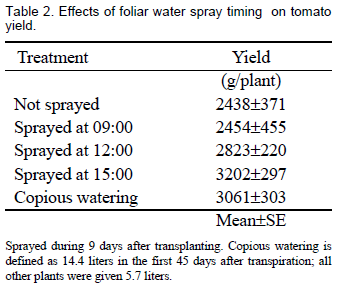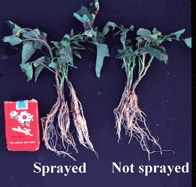Foliar water spray reduces the aftereffects of plant damage caused by short dry spells
Description
Research into crop water stress has up to now chiefly focused on problems in the arid and semi-arid regions. Fewer studies have targeted minor water-stress problems in humid and semi-humid regions, since the problems experienced in these regions are the same as those in arid and semi-arid regions. One reason for the disproportionate effect of water stress during short dry spells in humid regions is that root growth and root quality are less extensive in a humid climate, resulting in slower water uptake during short dry spells. However, the aftereffects of short dry spells on plant productivity have not hitherto been analyzed in detail.
Table 1 shows the results of a comparative analysis of tomatoes grown in coarse and fine soil in an open field. The delineator between coarse and fine soils is whether clods over 2 mm in size account for more or less than 85% of the dry weight of plowed soil. The same volume of water was supplied to every plant base. Leaf characteristics and soil water were measured from 33 to 40 days after transplanting, and harvesting continued over four months. In plants grown in coarse soil, leaf area and first half yield decreased, but leaf thickness, leaf water, and soil water in plowed soil increased. High leaf and soil water content indicate decreased water absorption due to stomatal closure. It is of particular significance that leaf thickness increased in plants grown in coarse soil. These plants’ reaction to coarse soil appears to be xeromorphism, a response universally seen in CAM plants. Fig. 1 shows the time course of transpiration of sugarcane grown in the field with and without breakup of hardpan using a machine fork. Transpiration of the plants in the field without hardpan disruption was half that of plants grown in soil with broken-up hardpan. However, even after the end of the dry spell, this ratio did not recover for a month. The leaf water content of plants grown in the field without hardpan disruption was high in the humid season that followed the dry spell. These results were also a result of stomatal closure. We named this acute plant reaction to stomatal closure “xeromorphic reaction.” Fig. 2 shows serious xeromorphic reaction in tomato. The reason for its appearance is mild but uninterrupted water stress. Coarse soil, hardpan plowing by machinery, excessive application of fertilizer, intense solar radiation, continuous wind, low air humidity, high air temperature, etc., all cause the xeromorphic reaction.
Plant production depends on water uptake, fertilizer uptake, and photosynthesis. Our finding is that reduction in the rate of photosynthesis due to stomatal closure caused by xeromorphic reaction is one of the major contributing factors. It has the same growthlimiting effect as a water shortage, even during wet periods following short dry spells. The effect appears to be caused by irreversible stomatal closure.
It is well known that rainfall opens stomata, even after the leaf surfaces have dried. Foliar water spray in the evening acted in the same way as rainfall to increase stomatal conductance. As shown in Table 2, tomato plants that received foliar water spray every day for 9 days at 15:00 after transplanting showed yields higher by 30% than those of unsprayed plants, equivalent to the yield of plants supplied with three times as much water.
As shown in Fig. 3, two-year-old papaya plants grown in 80-liter pots using a drip fertigation system showed the xeromorphic reaction in spite of being supplied daily with nutrient solution. Foliar water spray at 16:00 increased stomatalconductance, photosynthesis, and transpiration up to 30 days after the end of the rainy season. As shown in Fig. 4, in tomatoes and papayas for which foliar water spray is available, leaf water loss significantly decreases leaf water potential. Because plants increase their physical water uptake in response to decreased leaf water potential, water uptake ability in these plants increases as a result of increased leaf water loss. These plants can easily be told apart by comparing the root growth of individuals with and without daily application of foliar water spray, as shown in Fig. 5.
Figure, table
-
-
Fig. 1. Plants grown in undisrupted hardpan areas showed low transpiration even after the end of the dry spell. -
Fig. 2. Severe xeromorphic reaction in tomato. -
-
Fig. 3. Effect of foliar water spray on stomatal conductance, photosynthesis, and transpiration of papaya plants. Two-year-old papaya were grown in 80- liter pots in a greenhouse.
Daily foliar water spray was applied at 16:00 from June 2, the end of the rainy season. -
Fig. 4. Relation between leaf water loss and leaf water potential in tomato, melon, and papaya cut leaves. -
Fig. 5. Sweet potato transplants with and without foliar water spray daily at 16:00 for 5 days.
- Affiliation
-
Japan International Research Center for Agricultural Sciences Okinawa Subtropical Station
- Classification
-
Technical A
- Term of research
-
FY1995、FY2000~2003
- Responsible researcher
-
OZAWA Kiyoshi ( Development Research Division )
FUKAMACHI Hiroshi ( Okinawa Subtropical Station )
CONTRERAS Samuel M. ( Department of Agriculture The Philippines, Bureau of Soil and Water Management )
- ほか
- Publication, etc.
-
Ozawa K., Yang G., Gulinur and Sameshima R.(1997):Effectiveness of some newly developed cultural practices to improve water use efficiency and vegetable growth in oasis farming. J.Agric. Meteorol.(Jpn.), 52, 629-632.
Fukamachi. H., Tukaguchi T., Ozawa K., Komori S. and Ogawa K.(2002):Effect of folia mist spraying on root growth and photosynthesis of papaya plant. Acta Hort., 578, 373-375.
Contreras M. S. and Ozawa K.(2005):Hardpan effect on sugarcane transpiration, growth and yield. J.Agric. Meteorol.(Jpn.), 61, 23-28.
- Japanese PDF
-
2004_17_A3_ja.pdf784.76 KB







